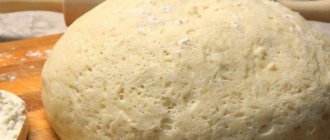Reviews (3)
7
Prepared by: Marina Sofyanchuk
08/11/2016 Cooking time: 1 hour 0 min
| Save | I cooked) | Estimate |
I offer a simple recipe on how to prepare straight dough quickly and without problems. This dough can be used to make pies, bagels and buns with both sweet and savory fillings.
Description of preparation:
The recipe for a straight yeast dough is not much different from a regular yeast dough on a sponge, the only thing is that more yeast is put into it, since it must begin to act in the already kneaded dough.
Straight yeast dough requires less time to prepare, and the result is also very good. Pies made from this dough are soft, tender, they say that they do not go stale for a long time, but I have never been able to test this, because they are eaten very quickly. Purpose: For lunch / Inexpensive Main ingredient: Dough / Yeast dough / Yeast / Dry yeast Dish: Baking
Proofing the dough
After kneading and during cutting, the dough becomes denser. To prevent the products from being dense, the baking sheets with the molded dough should be placed in a warm, damp place (without drafts) and covered with a napkin.
. Under these conditions, additional fermentation will occur in the dough, which is called proofing.
During proofing, the buns increase in volume and become fluffy due to the formation of carbon dioxide inside them. Interestingly, proofing of small and rich products lasts longer
than large and less rich ones. You should learn to correctly determine by touch the moment when proofing ends. Short-proofed dough is usually dense; well-seasoned - airy, and the buns made from it will be soft.
If the proofing is insufficient, the products will be small in volume, fluffy, poorly baked, heavy and with cracks; eating such baked goods is not at all pleasant. But even with excessive proofing, the products are also not good - they are blurry, and the baking crumb has uneven large pores.
How to make “Steamless yeast dough”
Prepare all the necessary ingredients.
Dissolve dry yeast in warm milk until completely dissolved, add powdered sugar and salt.
Then pour in the melted butter and beat in one egg. Mix everything well so that all ingredients are combined.
Begin to gradually add flour in small portions and knead the dough with a spoon. Once all the flour has been added, turn the dough out onto your work surface and knead gently.
Leave the dough for 30-40 minutes in a warm place (I put it near the switched on burner). Straight yeast dough is ready to prepare delicious homemade baked goods.
Preparation of wheat dough using the straight method and using thick dough: methods for preparing the dough
The jet of mixture emerging from the slot causes the plate to vibrate at an ultrasonic frequency. As a result of the impact of the generated wave, the fat droplets are crushed, creating a thin emulsion. The composition of the emulsion to be added to the dough is given in table. 14. Depending on the concentration and properties of the fat used, a stable, finely dispersed emulsion is obtained in 30-60 minutes. The emulsion is added to the dough, taking into account the required amount of fat. Margarine is replaced with an emulsion at the rate of 0.85 kg of vegetable oil instead of 1 kg of margarine. Moreover, phosphatide is administered instead of 0.25-0.75% fat. If phosphatides are dark in color, it is not recommended to add them to the dough from grade I flour more than 0.5%, and from premium grade flour - more than 0.25% by weight of flour. Good results are obtained by adding potassium bromate (0.001-0.003% by weight of flour) along with the emulsion. VNIIHP also recommends using concentrated fat-water emulsions for preparing the dough, consisting of 67-69% vegetable oil, 27-29% water and 4% sunflower or soy phosphatides [65]. Emul-
Rice. 15. Installation for the preparation of concentrated fat-water emulsions. This composition has a liquid consistency, light cream color and is stable - it does not separate for 10-15 days. To obtain a concentrated emulsion, an installation is recommended, the diagram of which is shown in Fig. 15. Phosphatides are dissolved in oil by mixing them in vat 1 with a stirrer for 10-20 minutes. Then, water with a temperature of 20-22 ° C is taken into vat 2, the stirrer of which makes at least 960 rpm, and a mixture of oil and phosphatides is pumped there. The churning lasts 10-15 minutes, after which the emulsion is passed through emulsifier 3 to achieve a finer dispersion. The finished emulsion has a light cream color and a consistency that allows it to be transported through pipes. Its shelf life is up to 3 days. Fat-water emulsions can be prepared using churning machines or by forced recirculation using a powerful pump. The mixture of oil and emulsifier is heated to 50 ° C and mixed with water heated to 40-45 ° C. Emulsification is carried out at 200-250 rpm of the whipping machine blade for 10-12 minutes or by pumping through a closed pipeline from the bottom to the top of the vat . The influence of salt . The salt content in the dough for the vast majority of baked goods is 1.3-1.5% by weight of flour. It affects the intensity of swelling of colloids, the rate of enzymatic processes and the vital activity of yeast and bacteria in the dough. According to T.I. Shkvarkina [217], adding 1.5% salt to dough without yeast strengthens the dough and reduces the degree of liquefaction during storage. Its viscosity is higher. The gluten washed from such dough is weaker than from unsalted dough. The moisture content of gluten from salt dough is 1-2% higher. Its yield immediately after kneading is 2-4% more, and after the dough is kept for 2 and 4 hours it is 1-3% more than in dough without salt at the same time. Thus, adding salt increases the hydration of gluten. The yield of raw and dry gluten does not decrease, but even increases slightly. The effect of salt on gluten depends on its content in the dough. According to L. Ya. Auerman [4], adding salt to the dough up to 1% by weight of flour, if the dough rests for no more than 60 minutes, leads to an increase in the extensibility of the washed gluten. Adding more salt or increasing the dough resting period before washing, even with 1% salt, leads to a decrease in the extensibility of the gluten. E.I. Vedernikova [28] found that at the concentrations used for the test, table salt increases the hydration of gluten, and therefore the amount of washed raw gluten, which becomes softer, more extensible and spreading under the influence of salt. Maximum hydration and weakening of gluten is observed at a salt consumption of 2-2.5% by weight of flour. With a further increase in salt consumption, gluten becomes stronger, its hydration decreases, and it is washed out in smaller quantities. At a consumption of 8-10% salt, even dehydration is observed compared to gluten washed from dough without salt. Thus, with a small dosage of salt in the dough, an increase in the osmotic swelling of gluten in the dough is observed. The physical properties of the dough improve with increasing salt content, and the achievement of maximum consistency slows down. The dough becomes stronger, better retains its physical properties throughout the entire fermentation period and softens less. The spreadability of the dough decreases with increasing salt content. This is especially true when baking hearth bread. If there is no salt in the dough, the bread, due to the poor physical properties of the dough, turns out low and vague. The crust of the bread turns out to be unusually white and uncolored. This indicates that without salt, fermentation is more intense than with salt, and before baking there is no free sugar left in the dough, which is necessary for coloring the bread crust during baking due to caramelization of sugars and melanoidin formation. Effect of dough temperature . The physical properties of the dough depend significantly on its temperature. When the temperature rises to 35° C, the rate of swelling and peptization of colloids increases. At the same time, the action of enzymes is intensified, as a result of which the gluten is weakened and the physical properties of the dough deteriorate. Dough kneaded at elevated temperatures has a weaker consistency and liquefies faster during fermentation. When preparing dough in bowls, the fermentation temperature can be adjusted by placing them in a chamber at the required temperature. The dough is usually prepared in the temperature range of 26-32 ° C, since yeast cells multiply best at a temperature of 25-27 ° C, and the optimal temperature for their fermentation is 30-36 ° C. At this temperature, the yeast ferments intensively for a long time. When the temperature rises above 30° C to a certain limit, the fermentation process occurs more intensely, but the yeast quickly weakens, and after some time the intensity of fermentation decreases. Temperature is therefore one of the main factors in controlling the rate of fermentation. The optimal temperature for the development and vital activity of most dough bacteria is 30-35° C. As the temperature of the dough increases, its acidity also increases, which should be kept in mind when speeding up the fermentation process by increasing the temperature. Therefore, when designing dough preparation units, due attention should be paid to the possibility of regulating the fermentation temperature. Preservation of dough and dough In the summer, bakeries have to take measures to prevent an excessive increase in the acidity of dough and dough. Sometimes it is necessary to preserve dough and dough due to sudden breaks in work. For this purpose, P. M. Plotnikov tested the influence of adding table salt, bicarbonate of soda, calcium oxide and hydrochloric acid to wheat dough. All these substances reduced gas formation. Table salt almost did not reduce acid accumulation, soda and calcium oxide neutralized the acid, but did not affect the activity of bacteria, and hydrochloric acid greatly increased the initial acidity, and, despite the fact that it suppressed bacterial microflora, it could not be recommended for wheat dough. P. M. Plotnikov was the first to develop a method for preserving wheat dough and dough by adding 0.5% baking soda by weight of flour to them. This method has been introduced into industry. The experience of its use at the factories of the Novosibirsk Trust of the Baking Industry showed [205] that with the indicated dosage of soda, the dough and dough ferment normally, but take 2.5-3 hours longer, and their acidity decreases sharply. The porosity of products in some cases even increases by 3-5%. The taste properties of the products do not deteriorate and they meet the requirements of the standard. When preparing lamb dough, adding 0.1% soda to the weight of flour in the dough significantly improves its physical properties, which is important for cutting in the summer. At the same time, the acidity of the dough decreases and the swelling coefficient of simple bagels increases by 0.2-0.3 units. If it is necessary to delay the maturation of the dough for up to 8-12 hours, according to VNIIKhP [94], it is enough to add half the amount of yeast to the dough (0.5% pressed or 10-12% liquid) and knead it at a temperature of 25-26 ° C. Our Studies have shown that bread of normal quality can be obtained by increasing the fermentation time of liquid yeast, sourdoughs and heads to 16 hours by decreasing the temperature of their fermentation. Adding salt to semi-finished products to inhibit the fermentation process at 30° C leads to a decrease in the quality of semi-finished products and bread, and when combined with low fermentation temperatures it gives good results. Mechanization of the movement of bowls on conveyors The process of preparing dough in rolling bowls has serious disadvantages. The need to roll bowls manually involves a lot of hard physical labor. Since loaded bowls are very heavy, it is necessary to line the floors in the dough mixing department with expensive metal plates, which consumes a lot of metal. This also adds weight to the building's structures. Preparing dough in bowls in portions has another technological disadvantage. Since the cutting of dough contained in one bowl sometimes lasts up to 1 hour, the first and last portions of dough taken from the bowl are not equally subject to fermentation processes, and the dough is not equally “ripe” when it comes to cutting. Elimination of these shortcomings is possible: a) by mechanizing the movement of bowls by installing them on a conveyor; b) preparing dough in portions in large-capacity bins, the movement of which is mechanized; c) preparing dough in a continuous flow in permanently installed units. G.P. Marsakov, during the construction of the first large bakeries in the USSR, was the first in the world to use a rigid ring conveyor, creating a new type of bakery. It consists of two rings of rails on which bowls are installed at equal distances from each other. They can rotate around their vertical axes. The conveyor rings lie on rollers mounted on the floor. Along the bowl conveyor, kneading machines for kneading dough and dough, a machine for kneading dough and a bowl tipper are installed in series. The conveyor moves periodically at a distance equal to the step between adjacent bowls, then it stops for a short time, during which the dough is mixed in one bowl, the dough in another, the dough is kneaded in the third, and the fourth is emptied and returned to the conveyor. Rice. 16. Diagram of a ring dough-preparing dish unit with dough pumping. The use of ring bowl conveyors does not eliminate the main disadvantage of preparing dough in bowls—portioning—but it completely mechanizes the process of transporting bowls. Considering that it also becomes possible to mechanize all other operations for preparing dough, this method of organizing labor is very promising. Ring bowl units have been created and are successfully operated at factories in Leningrad [124]. The ring unit with dough pumping (Fig. 16) consists of two eccentrically placed movable ring platforms. On the outer 8 there are 12 bowls with a capacity of 600 liters, intended for fermenting the dough, and on the inner ring 11 there are 4 such bowls for fermenting the dough. The conveyor frame is made of channel No. 14, the 700 mm wide deck is made of 8 mm steel. The outer diameter of the large ring is 5600, the inner one is 2300 mm. Conveyors are installed on rollers, some of which are driven. The dough conveyor is driven by an electric motor with a power of 5.1, and for dough - 3.4 kW. The operating weight of the conveyors for dough is 14 tons, and for dough 5 tons. Above the bowl conveyors there are two KhTSh dough mixing machines with stationary bowls that have hatches in the center of the bottoms that are closed with valves. One machine 1 is used for kneading the dough, and the second 7 is for kneading the dough. Each of them is serviced by a VNIIHP-0-6 dosing station and a control panel. The dough bowls have discharge holes with a diameter of 370 mm in the bottoms, closed by valves, and the dough bowls are turned over for unloading using a special tipper 9. The installation works as follows. To knead the dough, flour is taken into the bowl of the kneading machine 7 from the automatic flour tester 4, a suspension of yeast and water from measuring cups 5 and 6. After kneading, the hatch of the bowl opens and the dough is loaded through a guide funnel into the bowl of the sponge conveyor. Rhythm of dough kneading 33 min. After 5 hours, when the conveyor rotates 330°, this bowl stops above the unloading hopper 75, the bowl hatch automatically opens, the dough is unloaded and is pumped by screw pump-12 through a pipe with a diameter of 180 mm to a height of 8 m into hopper 2. Under it there is a dosing auger, with which the required portion of the dough is fed into the bowl of the kneading machine 1 for kneading the dough, where the saline solution is supplied from the measuring cup 3. The kneaded dough is unloaded through the bottom hatch of the bowl and the guide funnel into the bowl of a small conveyor for fermentation. After 1.5 hours of fermentation, when the conveyor rotates 270°, the dough from the bowl is unloaded into hopper 10 using a tipper 9. The bowl with dough and dough is stopped at the unloading position automatically using a limit switch VK-211. The duration of fermentation of the dough and dough can vary due to the length of time the bowl is left at the unloading and loading positions. The screw pump for pumping dough with a capacity of 2.4 t/h has 10 turns with an uneven pitch. It is driven by a 4.5 kW electric motor at 1440 rpm through a gearbox with a gear ratio of 1/20 at a speed of 120 rpm. This installation produces sliced loaves from grade I flour. The plant's capacity is 12.5 tons of loaves per day. It serves the BN-25 or FTL-2 oven with 30 cradles. At the Primorsky Bakery Plant in Leningrad there is an installation consisting of two ring bowl conveyors located one above the other. They differ
Rice. 17. Ring basin unit for preparing dough with reverse movement. because they have a reversible motion and can rotate in two directions. The ring conveyor for preparing dough (Fig. 17) has a flooring 1 made of 10 mm steel. Its outer diameter is 6250, internal 4650 mm. It is placed on 12 casters at a level of 380 mm from the floor. 11 HDSh 2 bowls with a radial angle between them of 33° are mounted on it. The conveyor is equipped with three drive stations 5, of which one is spare. The drive station consists of a 1 kW engine with 920 rpm, a worm gearbox with a gear ratio of 1:37 and a bevel gearbox with a gear ratio of 4.5. Bowls 2 with two axles of the rear wheels are hingedly supported by two stands attached to the conveyor, and a stand not connected to the conveyor is welded to the front part of the carriage. Thanks to this, the bowl can tilt 118° for emptying into the dough dispenser 5. This is done using a chain tipper 4 with reversible stroke. The latter is driven by an electric motor (1 kW, 920 rpm). Duration of bowl overturning is 25 seconds. After emptying and cleaning, the bowl returns to the conveyor to its original position. Rice. 18. Ring bowl unit for dough fermentation with reverse movement. To knead the dough, there is an HTSh 7 kneading machine in the middle of the ring conveyor. Its lever makes 32 movements per minute. The latter is elongated, since the bowls on the conveyor are somewhat removed from the machine. To rotate the bowl in which the kneading is carried out, there is a separate drive 6. The bowl makes 5.85 rpm. Thus, on this conveyor, the dough is kneaded, fermented, and dough is kneaded, which is loaded into the bowls of the test conveyor for fermentation. The ability of the conveyor to rotate in any direction creates greater maneuverability and allows you to simultaneously prepare a wide range of products. The ring conveyor for dough (Fig. 18) consists of 4 bowls 1 with a capacity of 600 liters. It serves only for dough fermentation and is equipped with a drain funnel 2, a tipper 3 above the dough outlet 4 and a drive station 5, consisting of an electric motor, a three-stage spur gearbox and a gear transmission. In Czechoslovakia, similar conveyors with 5–11 bowls are also used [46]. The unit contains one or three kneading machines with working bodies that descend into the bowl when it is installed underneath them. If there are three machines, one is used for kneading the dough, the other is for kneading the dough, and the third performs kneading. In accordance with the purpose of the machine, the working parts are made in various configurations. Preparation of wheat dough using the sponge method on a small-sized bunker unit of the n system. f. Gatilin To mechanize the dough preparation process, N. F. Gatilin created a small-sized bunker unit designed for preparing wheat dough using the sponge method and rye dough on BAG-20/25 heads [33]. The design of the unit is based on the principle of preparing dough, heads and dough in sectional cylindrical bins with conical bottoms, periodically rotating around their vertical axes. In the unit, the diagram of which is shown in Fig. 19, there are two bunkers: one for preparing dough 2, the second for dough 10. Sections of the bunkers are alternately filled with dough and dough, which are ripened and released from them during one revolution of the bunkers. Volume of bunkers: sponge (head) 5.9 l3 and test 5.1 l3. Each bunker has six sections. When producing dough from wheat flour, the unit operates as follows. The dough is kneaded in a dough mixing machine 5, into which flour is supplied in the required quantities from a flour mixer 4, water and an aqueous suspension of pressed yeast or liquid yeast (or a mixture thereof) from a dosing station 3. To make dough from wheat and rye flour, dough mixing machines of the brand are installed “Standard” with a stationary bowl with a capacity of 330 liters, in the center of the bottom of which there is a hole that is closed by a hinged hatch. The kneaded dough is loaded into one of the sections of hopper 2; when this section is full, the hopper is rotated to the angle occupied by one section, and the dough continues to be loaded into the second section, and so on. The rhythm of batches entering one section and the rhythm of changing sections are set so that by the time the last section begins loading, the dough located in the first section is ready for unloading. During the filling of the last section, the first one is released and after the next rotation of the hopper it becomes ready for loading. The finished dough goes down into funnel 1.
To pump the dough, a screw pump 12 with a diameter of 200 mm is installed under the hopper, the screw of which has a pitch of 180 mm and makes 83 rpm. Its productivity is about 90 kg of dough per minute. The dough is pumped through a pipe with a diameter of 200 mm into the hopper of the dough dispenser 6 with an auger, which is installed on a scale above the kneading machine for kneading dough 7. The productivity of the dough dispenser screw (diameter 125 mm, pitch 80 mm, number of revolutions per minute 97) is about 20 kg of dough per minute. When processing rye flour with sourdough, a method can be used to liquefy thick sourdough, as in a large apparatus (see page 91). In this case, a paired head liquefier and liquid dispensers must be installed under the sponge hopper. Flour for kneading the dough is dosed by an automatic flour dispenser 8, and liquid ingredients by a dosing station 9. The kneaded dough, like the dough, is sequentially loaded into sections of the hopper 10u, which operates on the same principle as the dough hopper. The finished dough is unloaded and enters the dividing machine 11. For dosing flour, MD-100 automatic flour meters are installed, and for liquid ingredients, VNIIKhP membrane-weighing dosing stations are installed. The productivity of the unit is 20-25 tons of bakery products per day, at which the estimated duration of fermentation of the dough or head is 4, and the dough is 1.5 hours. The operation of the entire unit is automated. Its dimensions are length 6100, width 4500, height 6900 mm. Thus, the entire unit consists of two independently working parts for the dough and for the dough. When mastering the units of N. F. Gatilin’s system, fears arose that the dough would be mixed in sections due to the fact that previously loaded portions of it, which had already undergone fermentation, were lighter and could float. This would lead to the fact that ripe dough would be on top, and freshly kneaded and, therefore, unfermented dough would be released from the bottom. There were also doubts whether the dough in the bins would become excessively sour due to dough particles clinging to the walls and corners when the section was emptied. Research by V. S. Geishtor [37] showed that the dough in sections is not mixed due to the fact that its volumetric weight remains constant during the first 10-12 minutes, and decreases by only 1.5% over the next 5 minutes. Thanks to this, when loading bunkers with dough, sequentially loaded portions are not mixed, but are arranged in layers. This does not occur even if the dough is kneaded at different moisture levels. This is apparently explained not only by the constancy of the volumetric weight of the dough at the beginning of fermentation, but also by the high viscosity and, therefore, low fluidity of the dough. A study of the fermentation process of dough and dough in bunker units conducted by A. S. Grishin [47] showed that as a result of reduced heat loss to the environment and a smaller open surface of the fermenting mass, its temperature rises somewhat faster than during fermentation in bowls. The acidity of the dough and dough in bunker units also increases faster. Therefore, the duration of fermentation of dough and dough in them is reduced by 10-15% compared to fermentation in bowls. There is no mixing of different portions of dough and dough in the bunkers. A difficult task to solve when producing wheat bread on thick doughs using bunker units is the process of transporting the finished dough to the machine. kneading the dough. Factories use two options: diluting the dough and pumping it with gear pumps, and pumping thick dough with a screw pump. A study of the viscosity of semi-finished wheat products [361 showed that at a humidity of 47-50% it is (in n-sec/m2): for premium wheat flour 55-25, grade I - 90-30 and grade II 165-65, and the viscosity liquid sponges after fermentation: from grade I flour 0.52, grade II - 0.32. When thick dough is liquefied with water and saline solution to the same humidity, it has a lower viscosity. The authors explain this by the fact that in liquid dough during fermentation a network structure is formed that binds the water contained in it, while the structural skeleton formed in thick dough is destroyed when it is diluted with water and saline solution. It must be assumed, however, that this influence is explained not so much by the mechanical effect on the thick dough, but by the influence of the salt present in the medium. This is evidenced by the data of P. M. Plotnikov and his colleagues that liquid salted dough has a lower viscosity than fermented dough without salt [137, 141]. To transport thick dough from wheat flour of II, I and premium grades using screw pumps, it is recommended to prepare them with a moisture content of 43-46%. Their viscosity is 600-200 n-sec/m2. More liquid deposits are pumped unevenly, and at lower humidity the drive power increases significantly. If it is necessary to liquefy thick doughs for their transportation by pumps, it is recommended to cook them; humidity 46-48%, since when diluting dough with lower humidity, the gluten is washed off. With higher humidity of the dough, diluting it becomes easier, but dosing becomes less accurate due to high mobility. Dilution of thick doughs should last no more than 3 minutes, since the released carbon dioxide and foaming make it difficult to pump them with pumps, the productivity of which decreases with increasing mixing time of the diluted doughs. However, the method of diluting thick dough did not justify itself, since in a number of cases gluten was washed off, which wrapped around the mixer blades and, getting into the pump, interfered with the uniform pumping of the diluted dough. Therefore, thick dough is now pumped with a screw pump. Some authors [47] note that pumping sponges, starter cultures and liquefied semi-finished products with pumps due to their additional mechanical processing helps improve the quality of products in terms of volume and porosity. In addition, the use of liquid or liquefied semi-finished products reduces the mixing time when kneading dough, and due to this, the duration of intensive dough kneading is extended. The technology and mode of preparation of dough and dough remain the same as in bowls, since they are prepared in bins in portions. A positive quality of bunker units of the N. F. Gatilin system is that they allow the production of a wide range of products. This is facilitated by batch preparation of dough and dough, which makes it possible to easily switch from producing one type of dough to another. Extensive experience in operating one of the first small-sized units of N. F. Gatilin’s system was accumulated at Leningrad Bakery No. 14, where it was introduced in 1962 [90]. It was used to produce dough for sliced and simple loaves from grade I wheat flour. Its daily productivity is 18.5 tons of products. The phase-by-phase recipe for preparing the dough is given in table. 15, and the technological regime is in table. 16. The quality of products produced by the unit is high. Phase-by-phase recipe, kg, dough preparation on a small-sized unit of the N. F. Gatilin system (for one batch)











